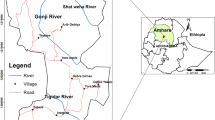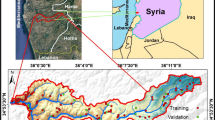Abstract
Landslide susceptibility is the likelihood of a landslide occurrence in an area predicted on the basis of local terrain conditions. Since last few years, researchers have attempted to analyse the probability of landslide occurrences and introduced different methods of landslide susceptibility assessment. The objective of this paper is to assess the landslide susceptibility in parts of the Darjeeling Himalayas using a relatively simple bivariate statistical technique. Seven factor layers with 24 categories, responsible for landslide occurrences in this area, are prepared from Cartosat and Resourcesat — 1 LISS-IV MX data. Each category was given a weight using the Information Value Method. Weighted sum of these values were used to prepare a landslide susceptibility map. The result shows that 8% area was predicted for high, 32% for moderate and remaining 60% for low landslide susceptibility zones. The high value (0.89) of the area under the receiver operating characteristic curve showed the high accuracy of the prediction model.
Similar content being viewed by others
References
Acharya, S.K. (1989) The Daling Group: its nomenclature, tectonostratigraphy and structural grain: with notes on their possible equivalents. Geol. Surv. India, v.22.
Aleotti, P. and Chowdhury, R. (1999) Landslide hazard assessment: summary review and new perspectives. Bull. Engg. Geol. Environ., v.58, pp.21–44.
Anbalagan, R. (1992) Landslide hazard evaluation and zonation mapping in mountainous terrain. Engg. Geol., v.32(4), pp.269–277.
Ayalew, L. and Yamagishi, H. (2005) The application of GISbased logistic regression for landslide susceptibility mapping in the Kakuda-Yahiko Mountains, Central Japan. Geomorphology, v.65, pp.15–31.
Basu, S.R. and Dey, S.K. (2003) Causes and Consequences of Landslides in the Darjeeling-Sikkim Himalaya, India. Geographia Polonica, v.76(2), pp.37–52.
Basu, S.R. and Ghotowar, L. (1990) Landslides and Soil-erosion in the Lish-Gish Basins of the Darjeeling Himalaya and their bearing on Floods. In: S.C. Singh (Ed.), Himalaya Environment Economy and People (pp. 189–207). New Delhi, India: R.K. Publications.
Bhattacharya, A. and Sengupta, C.K. (2001) Landslide Hazard Zonation along NH-31A from Sevok to Rangpo: A Terrain Evaluation Study. Jour. Engg. Geol., v.XXVII(1–4), pp.75–76.
Brabb, E.E. (1984) Innovative approachs to landslide hazard mapping. Proc. 4th Internat. Symp. Landslides, Toronto, v.1, pp.307–324.
Carrara, A., Cardinali, M., Guzzetti, F. and Reichenbach, P. (1995) GIS technology in mapping landslide hazard. In: A. Carrara, and F. Guzzetti (Eds.), Geographical information systems in assessing natural hazards, advances in natural and technological hazards research (pp. 135–176). Dordrecht, The Netherlands: Kluwer Academic Publishers.
Chauhan, S., Sharma, M., Arora, M.K. and Gupta, N.K. (2010) Landslide Susceptibility Zonation through rating derived from Artificial Neural Network. International Jour. Appld. Earth Observation and Geoinformation, v.12, pp.340–350.
Chung, C.F. and Fabbri, A.G. (1999) Probabilistic prediction models for landslide hazard mapping. Photogrammetric Engineering and Remote Sensing, v.65(12), pp.1389–1399.
Chung, C.F. and Fabbri, A.G. (2003) Validation of Spatial Prediction Models for Landslide Hazard Mapping. Natural Hazards, v.30, pp.451–472.
Dasgupta, S., Ganguli, J. and Neogi, S. (2004) Inverted Metamorphic Sequence in the Sikkim Himalayas: Crystallisation History, P-T gradients and implications. Journ. Metamorp. Geol., v.22, pp.395–412.
Dubey, C.S., Chaudhry, M., Sharma, B.K., Pandey, A.C. and Singh, B. (2005) Visualization of 3-D digital elevation model for landslide assessment and prediction in mountainous terrain: A case study of Chandmari landslide, Sikkim, eastern Himalayas. Geosciences Jour., v.9(4), pp.363–373.
Ghosh, S. and Carranza, E.J.M. (2010) Spatial analysis of mutual fault/fracture and slope controls on rocksliding in Darjeeling Himalaya, India. Geomorphology, v.122, pp.1–24.
Ghosh, S., Carranza, E.J.M., Vanwesten, C.J., Jetten, V.G. and Bhattacharya, D.N. (2011) Selecting and weighting spatial predictors for empirical modeling of landslide susceptibility in the Darjeeling Himalayas (India). Geomorphology, v.131, pp.35–56.
Ghosh, S., Günther, A., Carranza, E.J.M., van Westen, C.J. and Jetten, V.G. (2010) Rock slope instability assessment using spatially distributed structural orientation data in Darjeeling Himalaya (India). Earth Surface Processes and Landforms, v.35, pp.1773–1792.
Ghosh, S., Van Westen, C.J., Carranza, E.J., Ghoshal, T. B., Sarkar, N.K. and Surendranath, M. (2009) A Quantitative Approach for Improving the BIS (Indian) Method of Mediumscale Landslide Susceptibility. Jour. Geol. Soc. India, v.74, pp.625–638.
Ghoshal, T.B., Sarkar, N.K., Ghosh, S. and Surendranath, M. (2008) GIS based landslide susceptibility mapping — a study from Darjeeling-Kalimpong area, Eastern Himalaya, India. Jour. Geol. Soc. India, v.72, pp.763–773.
Gorsevsky, P.V., Gessler, P. and Foltz, R.B. (2000) Spatial prediction of landslide hazard using discriminant analysis and GIS. GIS in the Rockies 2000 Conference and Workshop, Applications for the 21st Century, Denver, Colorado, September 25–27.
Guzzetti, F. (2005) Landslide hazard and risk assessment. Ph. D Dissertation, Bonn.
Guzzetti, F., Carrara, A., Cardinali, M. and Reichenbach, P. (1999) Landslide hazard evaluation: an aid to a sustainable development. Geomorphology, v.31, pp.181–216.
Hutchinson, J. N. (1995) Keynote paper: Landslide hazard assessment. In: Bell (Ed.), Landslides. Rotterdam: A.A. Balkema, pp.1805–1841.
Kanungo, D. P. and Sarkar, S. (2003) Landslides and Terrain Parameters in Darjeeling Himalaya. Himalayan Geol., v.24(2), pp.55–62.
Kanungo, D.P., Arora, M.K., Gupta, R.P. and Sarkar, S. (2008) Landslide risk assessment using concepts of danger pixels and fuzzy set theory in Darjeeling Himalayas. Landslides, v.5, pp.407–416.
Kanungo, D.P., Arora, M.K., Sarkar, S. and Gupta, R.P. (2006) A comparative study of conventional, ANN black box, fuzzy and combined neural and fuzzy weighting procedures for landslide susceptibility zonation in Darjeeling Himalayas. Engg. Geol., v.85, pp.347–366.
Kanungo, D.P., Arora, M.K., Sarkar, S. and Gupta, R.P. (2009) A fuzzy set based approach for integration of thematic maps for landslide susceptibility zonation. Georisk, v.3(1), pp.30–43.
Magliulo, P., Lisio, A. D., Russo, F. and Zelano, A. (2008) Geomorphology and landslide susceptibility assessment using GIS and bivariate statistics: a case study in southern Italy. Natural Hazards, v.47, pp.411–435.
Martha, T.R. (2011) Detection of landslides by object oriented image analysis. University of Twente, Faculty of Geo-Information Science and Earth Observation. Enschede, The Natherlands: ITC Printing Department.
Meusburger, K. and Alewell, C. (2008) Impacts of anthropogenic and environmental factors on the occurrence of shallow landslides in an alpine catchment (Urseren Valley, Switzerland). Nat. Hazards Earth Syst. Sci., v.8, pp.509–520.
Miller, D.J. and Sias, J. (1998) Deciphering large landslides: linking hydrologic, groundwater and slope-stability model through GIS. Hydrological Processes, v.12(6), pp.924–942.
OFDA / CRED (2010) EM-DAT International Disaster Database — www.em-dat.net — Université Catholique de Louvain-Brussels-Belgium.
Oztekin, B. and Topal, T. (2005) GIS-based detachment susceptibility analyses of a cut slope in limestone, Ankara-Turkey. Environ. Geol., v.49, pp.124–132.
Pawde, M.B. and Saha, S.S. (1982) Geology of the Darjeeling Himalaya. Geol. Surv. India Misc. Publ., No.41, Part-II, pp.50–55.
Pradhan, B. (2010) Landslide Susceptibility mapping of a catchment area using frequency ratio, fuzzy logic and multivariate logistic regression approaches. Jour. Indian Soc. Remote Sens., v.38(June), pp.301–320.
Ramakrishnan, D., Ghose, M. K., Vinu Chandran, R. and Jeyaram, A. (2005) Probabilistic Techniques, GIS and Remote Sensing in Landslide Hazard Mitigation: A Case Study from Sikkim Himalayas, India. Geocarto International, v.20(4), pp.53–58.
Regional Sericulture Research Station (2010) Weather data (Unpublished), 7th Mile, Reshambari, Kalimpong, West Bengal, India.
Sarkar, S. (1999) Landslide in Darjeeling Himalaya. Transactions, Japanese Geomorphological Union, v.20(3), pp.299–315.
Sartohadi, J., Samodra, G. and Sri Hadmoko, D. (2010) Landslide Susceptibility Assessment using Heuristic Statistically Method in Kayangan Catchment Kulon Progo Yogyakarta-Indonesia. Internat. Jour. Geoinformatics, v.6(3), pp.23–28.
Soeters, R. and Van Westen, C. J. (1996) Slope instability recognition, analysis and zonation. In: A.K. Turner, and R.L. Schuster (Eds.), Landslide investigation and mitigation (pp. 129–177). National Research Council, Transportation Research Board Special Report 247.
Süzen, M.L. and Doyuran, V. (2004) A comparison of the GIS based landslide susceptibility assessment methods: multivariate versus bivariate. Environ. Geol., v.45, pp.665–679.
Tasser, E., Mader, M. and Tappeiner, U. (2003) Effects of land use in alpine grasslands on the probability of landslides. Basic Appl. Ecol., v.4, pp.271–280.
Vanwesten, C.J. (1993) Application of Geographical Information System to landslide hazard zonation. ITC, International institute for aerospace and earth res. surv. Enschede, The Netherlands: ITC Publication.
Van Westen, C. J., Rengers, N., Terlien, M. T. and Soeters, R. (1997) Prediction of the occurrence of slope instability phenomenal through GIS-based hazard zonation. Geologische Rundschau, v.86, pp.404–414.
Yalcin, A. (2008) GIS-based landslide susceptibility mapping using analytical hierarchy process and bivariate statistics in Ardesen (Turkey): comparison of results and confirmations. Catena, v.72, pp.1–12.
Yin, K.J. and Yan, T.Z. (1988) Statistical prediction model for slope instability of metamorphosed rocks. Proceedings of the 5th international symposium on landslides, Lausanne, Switzerland, v.2, pp.1269–1272.
Author information
Authors and Affiliations
Corresponding author
Rights and permissions
About this article
Cite this article
Sarkar, S., Roy, A.K. & Martha, T.R. Landslide susceptibility assessment using Information Value Method in parts of the Darjeeling Himalayas. J Geol Soc India 82, 351–362 (2013). https://doi.org/10.1007/s12594-013-0162-z
Received:
Revised:
Published:
Issue Date:
DOI: https://doi.org/10.1007/s12594-013-0162-z




